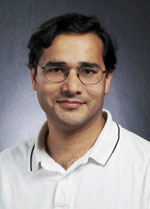Bio: Vineet Bafna joined the UCSD faculty on July 1, 2003, after seven years in the biosciences industry. He received his Ph.D. in Computer Science from Pennsylvania State University in 1994, and was a post-doctoral researcher at its Center for Discrete Mathematics and Theoretical Computer Science for two years. From 1996-99, Bafna was a senior investigator at SmithKline Beecham, conducting research on DNA signaling, target discovery and EST assembly. From 1999 to 2002, he worked at Celera Genomics, ultimately as Director of Informatics Research, at a time when Celera was decoding the human genome. He arrived at the Jacobs School from the Center for Advancement in Genomics, recently set up by Celera founder Craig Venter. Bafna has been on the Program Committees of the past two annual International Conferences on Research in Computational Biology (RECOMB), and is on the editorial board of the Journal of Bioinformatics and Computational Biology (JBCB). He received his B.Tech from the Indian Institute of Technology in 1989, and has published two dozen articles in major journals and conference proceedings.
Research: Professor Bafna is an expert in bioinformatics. He has published on many aspects of this emerging field, including genome rearrangements, multiple alignments, RNA structure, gene finding, DNA signals, mass spectrometric data analysis, and human population genetics. In genome rearrangement, he introduced (with his then-advisor and now UCSD colleague Pavel Pevzner) the breakpoint graph technique that is now commonly used when doing computational analysis of genome rearrangements. In computational proteomics, Bafna made key contributions to the problem of protein identification by devising a scoring function that incorporates ion fragmentation probability as well as instrument error, and an efficient algorithm to compute that score. He led a team at Celera that built a toolkit for identifying and quantitfying the Proteome using mass spectrometry. At UCSD, Vineet Bafna continues to focus on computational analysis of peptide mass spectra and applications to protein function, and analyzing data on single nucleotide polymorphisms (SNP), with applications to therapeutics and diagnostics. His ongoing algorithmic work on haplotype phasing will play an important role in the study of human genetic variations. Vineet Bafna has developed numerous toolkits for analyzing peptide sequences and other genomic data, including the Conserved Exon Method for gene finding (CEM) that uses conservation of coding regions in human and mouse genomes to simultaneously find gene structures in both species, and SCOPE and DiffXPro for identifying and quantifying proteins using mass spectrometry data.
|

